Analyzing Intel Core M Performance: How 5Y10 can beat 5Y71 & the OEMs' Dilemma
by Brett Howse & Ian Cutress on April 8, 2015 8:00 AM ESTCinebench R15 Single-Threaded Results
Cinebench will run the CPU up to 100% load for the duration of the test. As this is the single-threaded run, only one core will be active, which should in theory provide more headroom for that one core than when all cores (physical and virtual) are loaded. There is no burst workload here at all, and sustained single-threaded performance is the key for this test.
The Core i5 does exactly what would be expected for this benchmark. With just a single core loaded, the cooling system has no issues keeping the CPU from throttling. It maintains an extremely consistent CPU frequency during the run. This cannot be said of the two Core M-5Y71 devices though. The Dell Venue 11 Pro starts off with quite a high frequency, but as the temperature increases, the CPU drops in frequency to keep below the threshold of 90°C set on the SoC. At any opportunity, it increases its CPU frequency to try to increase performance, but generally that does not last for very long, and it ends up falling back down. The Yoga 3 Pro on the other hand, has a much lower allowed SoC temperature, with Lenovo locking in on 65°C as their maximum target temperature. This keeps the frequency down.
The ASUS Zenbook has an entirely flat CPU line though. The excellent heat dissipation of the chassis allows it to run for the duration of the benchmark with no throttling at all. It has to be noted though that the maximum CPU frequency is a quite a bit lower than the 5Y71 devices, topping out at 2.0 GHz versus 2.9 GHz for 5Y71. It would be very interesting to see how the UX305 would do with the faster CPU inside, and if it would run into throttling issues as well.

Looking at the average CPU frequency over the run shows that the i5 clearly has the most headroom, which is not surprising. Averages are only part of the story though, with both of the 5Y71 devices being able to jump past the 5Y10's frequency several times during the test.
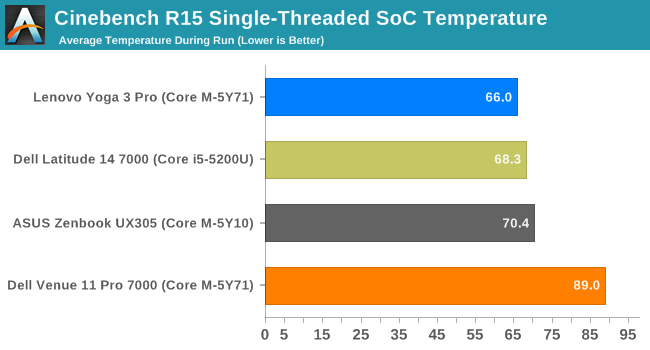
Looking at temperatures, it's interesting to note that the Dell Venue 11 Pro has the top-tier Core M-5Y71, but it puts that processor in what is the smallest chassis and with a plastic exterior. Consequently it quickly loads up to its maximum temperature and stays there for the duration. The rest of the devices stay much cooler with just a single core loaded.
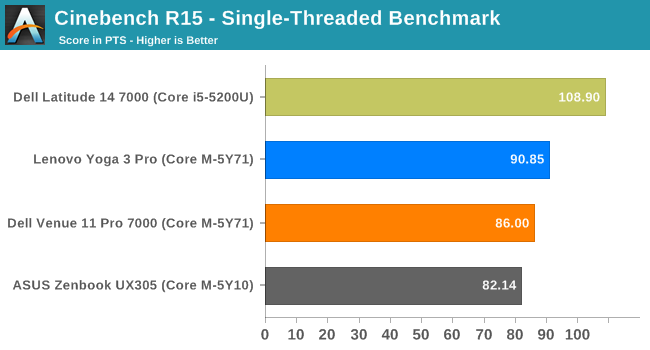
Here we have the actual benchmark results. On single-threaded workloads, the 5Y71 can and does outperform 5Y10. Despite the average CPU frequencies being lower on both 5Y71 devices, they had enough headroom when necessary to jump past the very consistent 5Y10. None of them can match the Core i5 in this test. It is actually very interesting that the highest scoring Core M in this test has the lowest average CPU frequency.


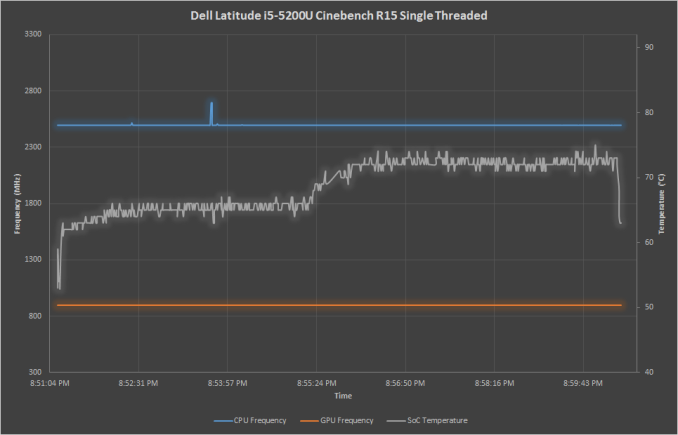
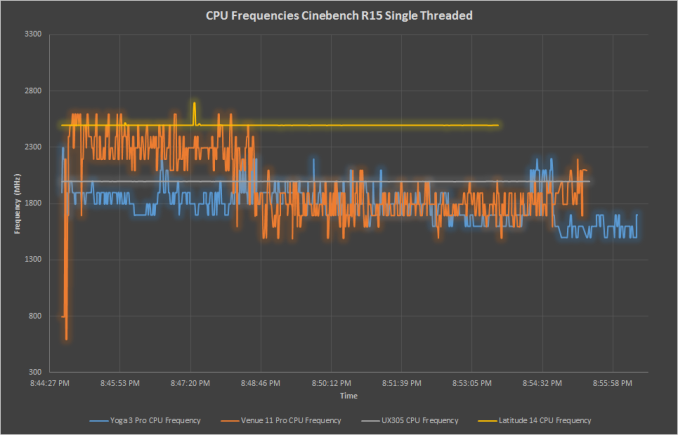
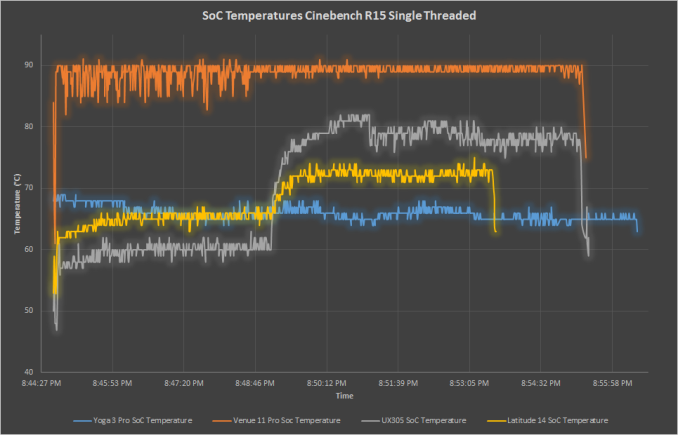








110 Comments
View All Comments
jjj - Wednesday, April 8, 2015 - link
You insist on only showing low power CPU results , because putting them properly in context would hurt sales right? God forbid you include laptops....And today somehow you decided to fully ignore AMD too.
Maybe stop working for Intel and serve your readers instead.
MrSpadge - Wednesday, April 8, 2015 - link
Dude.. WTF?This is an evaluation of what Core M is and what this means for devices using it. It's neither a comparison to other device and CPU classes, nor a general recommendation of this product.
Michael Bay - Wednesday, April 8, 2015 - link
AMD just can`t afford a decent shill anymore.THIS is what they go these days.
xthetenth - Wednesday, April 8, 2015 - link
I guess it's easy to confuse discussions of architectural details for devices that have already been reviewed on this very site with articles comparing those devices to other similar devices when the preexisting reviews contain many of the very comparisons you want.Dorek - Wednesday, April 8, 2015 - link
"And today somehow you decided to fully ignore AMD too."Only because the market does.
Refuge - Wednesday, April 8, 2015 - link
This article was never about comparing the CPU's to AMD or anyone. It was about explaining why we are getting awkward results across the board on the performance of these low TDP Intel parts.Nothing to do with AMD, or even the specific OEM's products either, so much as their construction and heat dissipation performance, but it was only in an effort to further explain the varying results of these low TDP Intel chips.
Pissedoffyouth - Wednesday, April 8, 2015 - link
Haha how does a 4.5w CPU for a laptop have anything to do with a 65w+ desktop CPU?Allan_Hundeboll - Wednesday, April 8, 2015 - link
If he was working for intel he would have included amd's "lowpower" cpuname99 - Wednesday, April 8, 2015 - link
Yeah, it's ridiculous.Why isn't there also a comparison against a POWER8 --- that would DEMOLISH this silly little Broadwell-Y.
And they're going on about how great the power dissipation is? Compare it against an ARM M0 and look who has crazy low power dissipation then!
I demand that every future AnandTech review compare any CPU against every other other CPU in the known universe, no matter how irrelevant the comparison...
lilmoe - Wednesday, April 8, 2015 - link
That price tag makes this the most confusing and out-of-place processor from Intel... Microsoft proved that Haswell-U can power an ultra-thin x86 tablet, have mobile SoC comparable battery life, and price it comparably or even lower than Core M products. All that with the added benefit of better performance...OEMs can take advantage of lower pricing on some Broadwell-U processors, and install a better/thinner active cooling solution with the savings. So where does that put Core M other than "luxury" devices that have no need for "real" performance advantages?
Not for me, thanks... Not at THAT price tag.